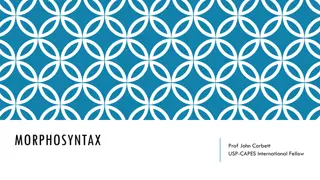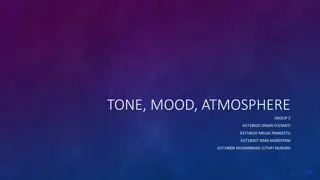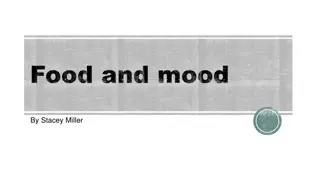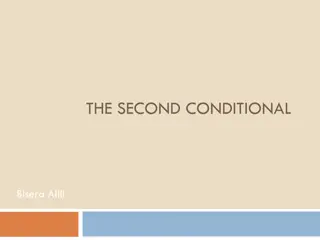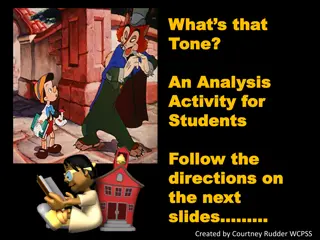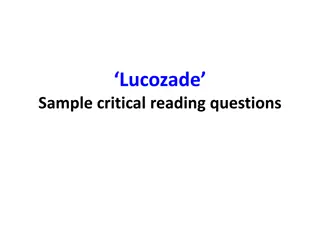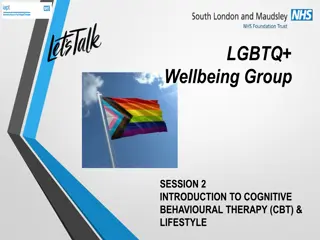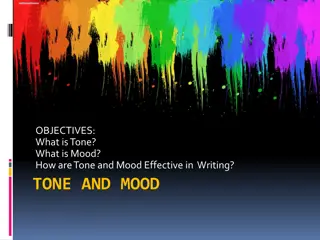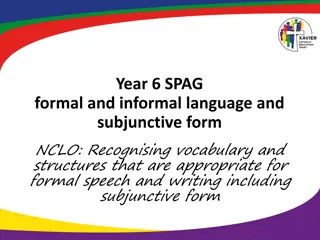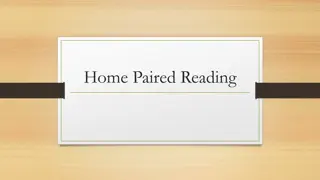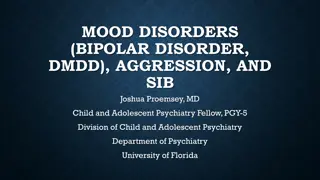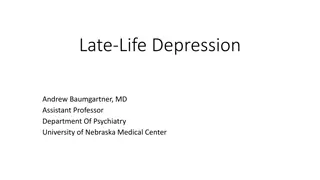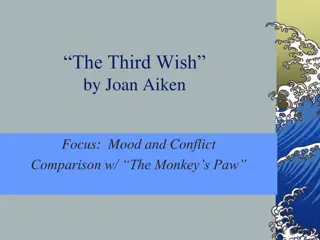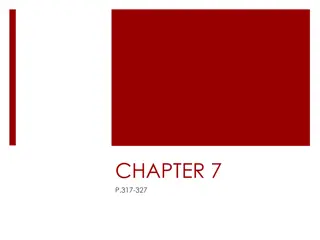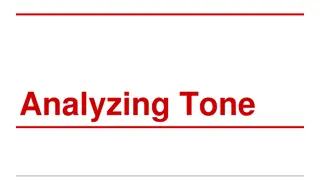Understanding the Spanish Subjunctive Mood: An Introduction
Explore the intricacies of the subjunctive mood in Spanish, distinguishing it from the indicative and imperative moods. Learn the general rules for differentiating between the indicative and subjunctive, and grasp the concept of mood versus tense. Through examples like Victoria studying Spanish and the interpretation of statements from a speaker's viewpoint, discover how the subjunctive expresses possibilities and uncertainties while the indicative deals with concrete facts and beliefs.
Download Presentation

Please find below an Image/Link to download the presentation.
The content on the website is provided AS IS for your information and personal use only. It may not be sold, licensed, or shared on other websites without obtaining consent from the author. Download presentation by click this link. If you encounter any issues during the download, it is possible that the publisher has removed the file from their server.
E N D
Presentation Transcript
EL SUBJUNTIVO UNA INTRODUCCI N Honors espa ol III Cap tulo 3
QU ES EL SUBJUNTIVO? The subjunctive (el subjuntivo) is one of three moods in Spanish. The other two Spanish moods are the indicative and the imperative. The subjunctive mood is used to talk about desires, doubts, wishes, conjectures, and possibilities. The indicative mood is used to talk about facts and other statements that are believed to be true and concrete. The imperative mood is used to give commands.
MOOD VS TENSE Mood vs. Tense Grammatical mood reflects a speaker's attitude toward a statement. As previously stated, Spanish has three moods: the subjunctive, the indicative, and the imperative. Grammatical tense refers to when an action takes place. Spanish has three tenses: the past, the present, and the future.
GENERAL RULES FOR DIFFERENTIATING BETWEEN THE INDICATIVE AND THE SUBJUNCTIVE The indicative mood is used to talk about things that are objective and/or certain. This includes things like facts, descriptions, and scheduled events. The subjunctive mood is used to talk about things that are subjective and/or possible, but not certain. This includes things like doubts, wishes, recommendations, unknowns, and opinions about the likelihood of other events occurring.
INDICATIVE OR SUBJUNCTIVE? Victoria studies Spanish. 1. 1. Indicative (fact from speaker s viewpoint) 2. Subjunctive (possibility, speaker is not sure) 3. Indicative (speaker s viewpoint is that he is sure she does) 2. It s possible that Victoria studies Spanish. 3. I m sure that Victoria studies Spanish. ** #3 even if she does not study Spanish, speaker believes she does, so for speaker it is a fact = indicative
GENERAL RULES FOR DIFFERENTIATING BETWEEN THE INDICATIVE AND THE SUBJUNCTIVE Did you notice the repetition of the phrase "from the speaker's viewpoint on the previous slide? This is key to understanding a very important point: "indicative" does not mean "true." As long as a speaker feels that what they're saying is true, the indicative can be used. This does not, however, mean that what they're saying is actually true.
LOOK AT THIS STATEMENT: Estoy seguro que los seres humanos tienen alas (I am sure that human beings have wings) The above statement is not true, but the speaker believes it is, so the second verb is in the indicative.
FEATURES OF SENTENCES THAT USE THE SUBJUNCTIVE There are three main features that most sentences that use the subjunctive share: 1) two subjects, 2) two verbs, and a 3) relative pronoun. (que/quien)
1) TWO SUBJECTS Most subjunctive sentences will have one subject in the main clause and one in the secondary clause. The attitude of the subject in the main clause is what triggers the use of the subjunctive in the secondary clause. The 2 clauses are separated by que. Laura quiere que t limpies el ba o. Laura wants you to clean the bathroom. (main clause and secondary clause separated by que) It is perfectly possible to use the subjunctive when both clauses refer to the same subject. Dudo que yo pueda ir a la fiesta. Espero que yo lo sepa hacer. I doubt I can go to the party. I hope I know how to do it.
2) TWO VERBS Most subjunctive sentences have two verbs: a verb in the indicative in the main clause and a verb in the subjunctive in the secondary clause. Laura quiere que t limpies el ba o. Laura wants you to clean the bathroom. (main clause (indicative) and secondary clause (subjunctive) separated by que)
3) A RELATIVE PRONOUN Most subjunctive sentences have a relative pronoun (such as que or quien) that links the main (indicative) clause to the secondary (subjunctive) clause. Laura quiereque t limpies el ba o. Laura wants you to clean the bathroom. (main clause and secondary clause separated by que)
KEY WORDS & PHRASES THAT TRIGGER THE SUBJUNCTIVE Another key to grasping the differences between the subjunctive and the indicative is understanding that certain words or phrases trigger the use of each mood. For example, words and phrases that indicate uncertainty trigger the subjunctive, while those that indicate certainty trigger the indicative. Many of the words and phrases that trigger the subjunctive fit into the acronym WEDDING, which stands for:
WEDDING (OR REASONS TO USE THE SUBJUNCTIVE) W E D D I N G Wish, want, will, & wequest ( ) Emotions W Yo quiero que tu vengas a la fiesta. E Estoy triste que no puedas venir. Doubt Denial Impersonal expressions D Ella duda que yo la invite. D Nosotros negamos que los chicos est n en la casa. I Es importante que salgan temprano Not known, non existent, need & negation God, guilt, grief N Necesito que ustedes estudien. G Ojal que el examen sea f cil



